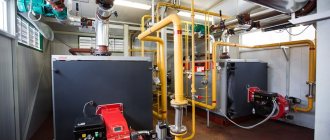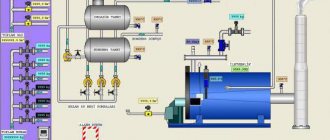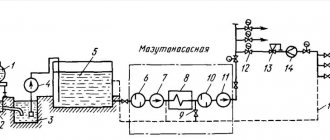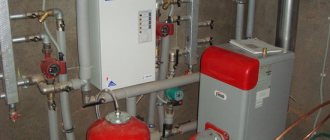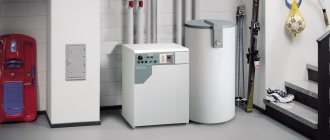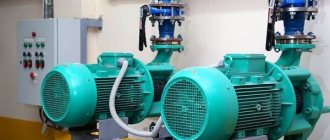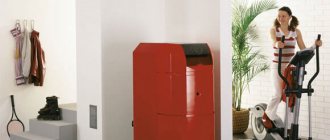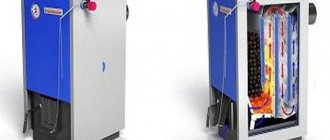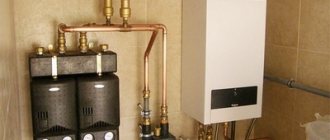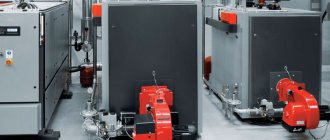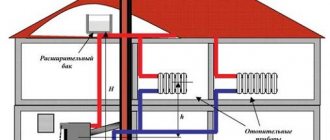Home / Boiler rooms
Back
Published: 10/27/2019
Reading time: 6 min
0
8909
A boiler plant (BU) consists of an interconnected set of equipment for generating steam and hot water in generation processes (CHP, CPP, NPP), production of various types of products and in central heating systems. Therefore, it is divided into energy, industrial and heating.
The source of steam production in the HRSG is drinking water, and the energy carrier is natural fuel. The heat transfer process is carried out through convective and radiation heat exchange using boiler tubes.
The organization of heat transfer occurs thanks to the coordinated work of complex components and elements of the steam generator, which are classified as main or auxiliary equipment.
- 1 Main equipment
- 2 Boiler room auxiliary equipment
- 3 Boiler room automation
- 4 Plants for the production of boiler equipment
Basic equipment
Schematic design of a boiler room with a deaerator
The main elements are structurally located within the boundaries of the boiler and serve to ensure the processes of generating thermal energy in the form of steam or hot water. Types of boiler equipment include:
- A boiler is a source of heat. They can be hot water, producing hot water for central heating and with a maximum temperature of up to 150 C, and steam, producing saturated or superheated steam of more than 1 MPa.
- The combustion device or furnace ensures complete combustion of the energy carrier. The process of fuel oxidation occurs in it, producing thermal energy.
- Boiler lining is necessary for thermal protection of boiler unit structures in order to reduce heat losses into the atmosphere and ensure gas tightness of the heat generator. It consists of fire-resistant materials that are rigidly attached to the frame of the unit.
- Frame – a metal structure to ensure the relative position of the working elements and the boiler.
- The superheater is used to heat the steam leaving the drum and separator to a temperature above the saturation point. Structurally, it is made in the form of heat-resistant steel coil pipes.
- A water economizer is used to heat the water entering the boiler feed circuit by reducing the temperature of the flue gases, thereby increasing the efficiency of the boiler. It is performed in the form of boiling and non-boiling type. In the first, the water is heated to boiling point, but in the second it never reaches it. Structurally, the device of the first type is made from packages of steel pipes, and the second - from cast iron.
- The air heater performs the task of heating the primary air in front of the boiler by cooling the combustion products; the process takes place in recuperative heaters.
- Shut-off and control valves are plumbing devices installed on the gas, water and steam paths of the boiler to regulate the flow of medium at the inlet and outlet of the unit. Shut-off - used to open/close sections of the thermal circuit. Regulating - used to maintain the specified operating parameters of the medium in terms of pressure and temperature. Safety valves, in the form of relief valves, are used in safety systems for emergency closure when high values of controlled safety parameters are reached. Special fittings include condensate drains and fuel filters; they are installed in the water and fuel supply systems of the boiler.
- The unit set is used for servicing the gas-furnace duct of the boiler. These include: manholes, hatches, doors, air dampers, explosion valves on gas ducts and soot blowers for cleaning boiler pipes from soot.
Water treatment for boiler houses - what is it?
There is no doubt that water treatment for boiler houses is a mandatory operation for the normal operation of their heating equipment. The working surfaces of boilers are susceptible to the formation of scale and lime deposits. If the treated water does not meet the quality requirements, the heating efficiency will decrease. Consequently, the efficiency of the entire heating complex will decrease. Proper water treatment for a boiler installation guarantees trouble-free operation of boiler equipment, providing consumers with heat on time and in the required volume.
Industrial and heating standards for water treatment in a boiler room are described in SNiP II-35-76. The document contains basic information about the required level of water quality in boiler houses. In particular, the water used must ensure uninterrupted operation of the thermal complex without the formation of corrosion damage, sludge and limescale deposits on the surfaces of working units and parts. Similarly, the steam level should be maintained at the planned level.
Boiler room auxiliary equipment
In order for heat transfer processes to occur effectively in the boiler, all flows of water, fuel and air must undergo a preparation process before being supplied to the unit. These tasks are performed by auxiliary boiler installations.
Group of pumps in a boiler room
The auxiliary elements of the boiler unit include the following devices:
- fuel supply systems;
- smoke purification systems;
- draft devices;
- feed and circulation pumps responsible for the movement of water along the circuit;
- boiler separation devices;
- water treatment plant.
Draft devices include smoke exhausters and fans operating in the gas-air duct system of the boiler. The former serve to create a vacuum in the combustion chamber and remove flue gases through the chimney into the atmosphere.
They are installed between the flue and the chimney, usually outside the boiler room, at the back of the boiler, due to the high noise level generated during operation.
Fans are designed to force air into the combustion chamber, to create a gas-air mixture at the outlet of the gas burner, to ensure complete combustion of the fuel. The device is also installed outside the boiler house building, but in front of the boiler front.
Separation devices are used to separate steam from boiler water; they are installed in the upper drum of the boiler. The water treatment system purifies feed water from hardness salts in sodium cation exchanger filters to reduce scale formation processes on the boiler heating surfaces of the boiler and removes active oxygen in the deaeration-feeding unit to reduce corrosion processes in the internal heating surfaces of the heat generator.
To power steam boilers, at least two electric pumps are installed, with an operating pressure of at least 1.25 pressure of the boiler water path, and a productivity of 110% of the rated steam output of all operating boilers.
In addition, two steam pumps are installed with at least 50% of the boiler room’s rated output.
Boiler room pumps are divided into:
- Feeding - designed to supply feed water to the boiler.
- Make-up tanks - for recharging the heating circuit in case of coolant leaks in the main networks.
- Network for coolant circulation in the supply and return pipelines. They are also used for hot water boiler houses.
- HVO pumps - in the chemical water treatment system.
- Gas equipment.
Operating principle of the boiler room
The general principle of operation of a boiler room is to carry out the process of obtaining thermal energy to heat water. Fuel from the fuel compartment/chamber or gas pipeline is sprinkled into the burner, where it burns, releasing heat. It heats the coolant, passing through a heat exchange unit, then the heated coolant (water or steam) enters the heating circuit or industrial steam pipeline.
If water is used only to provide heating, the cooled coolant is sent in the opposite direction, entering the boiler, and is heated again. A closed cycle is formed. Part of the heated water can be used for domestic purposes and consumed, and steam from steam boilers is also consumed for production processes. Using a make-up pump, pre-purified water is added to the heat exchanger - and everything is repeated until fuel is supplied to the firebox.
Removal of combustion products harmful to the human respiratory system is ensured by a chimney with a chimney. It is a hollow structure with a draft that facilitates the removal and dispersion of fuel combustion products in the atmosphere. The operation of most types of boiler rooms is controlled automatically.
Automation and dispatching
One of the main requirements for a boiler installation is the safety of its operation. Having dangerous units (boilers, related equipment), boiler installations have always needed attention and continuous supervision. In the old days, control over the functioning of boiler plants was carried out manually. Today, primitive schemes for monitoring the operation of boiler installations have been replaced by automated electronic systems.
The automated system includes special equipment that controls the operation of the boiler room. Boiler systems need automation in order to take immediate action in the event of failures, right during the production process.
Advantages of dispatching
Installing an automated system allows you to:
1. Monitor such operating indicators of the boiler room as:
– pressure in the system;
– make-up level in each unit unit;
– temperature values.
2. Set the boiler installation parameters at which it will operate in optimal mode. A special control panel is used for this.
3. Quickly report a problem in the event of an accident.
4. Constantly receive logs and reports that record events and parameters during the operation of the installation.
Dispatching allows you to fully automate and improve the operation of the boiler plant. The scope of work for installing a control system includes:
· Development of a dispatch project.
· Selection of equipment with high reliability and efficiency.
· Perform connection and commissioning activities.
· Providing after-sales service.
Practical experience in operating boiler plants regularly confirms that you cannot skimp on safety. A properly installed control system will pay for itself in a short time by reducing the cost of testing, make the operation of boiler equipment easy, and prevent emergency situations from occurring.
What boilers are installed in boiler rooms
The basic equipment that guarantees the functioning of the boiler room is the boiler. With its help, fuel is processed and converted into thermal energy, which subsequently enters coolants and various heating equipment. As the name of a gas boiler implies, gas is used as a fuel source for its operation. At the same time, the methods for constructing such installations should ensure their operation with minimal labor input.
It should also be noted that many boiler houses have turbocharged and atmospheric gas boilers. In the first version, the units are equipped with a closed combustion chamber and a built-in ventilation system that takes air from outside. Atmospheric boilers operate similarly to a conventional stove, in which the air flow from the room enters the chimney due to the presence of natural draft.
Considering the distinctive features of boilers, it must be said that they can have one or two circuits. Single-circuit installations are used only for the purpose of heating housing, double-circuit installations perform two tasks - they heat the housing and supply heated water to the water supply system of the premises.
Differences in gas installations also appear in the ignition method. It can be either electronic or piezoceramic. The electronic version is much more convenient, as it ensures ignition of the gas without human participation in this process. Piezo ignition always requires the intervention of an outsider. For the piezo ignition to work, a person must press a special button.
Boilers by type of fuel used
Depending on the type of fuel used, boiler houses are:
1. Gas. Gas is the main advantage of such units, since this type of fuel is environmentally friendly and economical. Gas heat supply and waste removal systems are simple, so they can be easily automated.
2. Liquid fuel. Oil, diesel fuel, waste oil compounds and fuel oil can be used as fuel for such heat supply systems. The launch of such installations does not require official permits or agreements.
3. Solid fuel. The source of fuel in them can be briquettes made from waste from agricultural processing and timber processing industries, coal, firewood and peat. The main advantage of solid fuel boiler houses is the low cost of fuel and its availability. The disadvantages of the installation include the need for an ash and slag removal device and a heat supply unit.
The principle of operation of boilers with different coolants
Based on the type of coolant, boiler houses are divided into:
1. Hot water. This type of installation is widely used for heating residential buildings, municipal buildings and industrial facilities. The heat source is water, which is heated to +115 °C.
2. Steam. They are in demand for heating industrial buildings. The coolant in such boiler houses is steam.
3. Combined. We speak of combined boiler rooms when two types of boilers are used simultaneously. In situations where it is necessary to ensure the supply of hot water for heating the room, its ventilation and water supply, water heating units are used. Steam boilers are started to support production cycles.
4. Boilers running on diathermic oil. The operation of such boilers is carried out by processing organic high-temperature compounds, the heating of which can occur up to 300 °C.
Operating principles of stationary and block-modular boiler houses
Depending on the placement method, two types of installations are distinguished:
1. Stationary. They are in demand when there is a need for equipment with a capacity of more than 30 MW. They are also needed in cases where there are no conditions for the construction of a block-modular unit. They refer to capital construction projects that have their own walls, foundation and roofing. Installation of such boilers is carried out on site.
2. Block-modular. These installations are becoming increasingly popular in Russia in comparison with stationary boiler houses. They are in demand because:
– quickly installed and put into operation;
– distinguished by their mobility;
– have almost complete factory readiness for installation;
– allow you to increase power by adding blocks;
– have independent functioning;
– guarantee good efficiency.
It is worth remembering that block-modular boiler systems are divided into several subtypes based on location. They are:
– basement;
– built-in;
– free-standing;
– attached.
The operating principle of stationary boiler houses and BMK does not differ significantly.
Operating principles of manual and automated systems
Depending on the level of automation, the following types are distinguished:
1. Manual. In such boiler houses, small units are used, where fuel is supplied manually by a person. Their work process looks like this:
– the operator on a trolley delivers fuel (it can also be supplied through a special bunker, where external loading is provided);
– ash is removed from the waste bin by a person manually or transported by trolley.
2. Mechanized. These are modern solid fuel boilers, the equipment of which allows to minimize human labor. Thus, fuel is supplied using special lifts (conveyors). In this case, the coal first goes through the stage of crushing in a crushing plant and purification in a chip catcher and metal catchers. Slag waste is removed using various equipment (hydraulic, mechanical or combined).
3. Automated. The operation of such boiler houses requires minimal human participation in the production process, thanks to its full automation. It is usually possible to fully automate gas boiler houses that use main natural gas as fuel.
Boiler room automation
Pumping group in BMK
Technological boiler processes are characterized by interrelated parameters of the working media: pressure of steam, water, gas, vacuum in the furnace, amount of primary air, feed water and gas.
The boiler room protection system provides:
- regulation of thermal processes;
- control in water, air and fuel systems;
- technological process management;
- alarm about the emergency condition of the boiler unit.
It can be partial, regulating only some stages of production, or comprehensive, when equipment maintenance is carried out without personnel.
Main automation tasks:
- Adjustment of the volume of air and fuel, in accordance with the regime maps for the load of the boiler unit.
- Providing draft in the combustion device and at the outlet of the steam generator.
- Feeding boiler pipes with water.
- Adjustment of steam and hot water parameters.
There are automation systems:
- With adjustment based on parameter deviation, that is, control depends on changes in the controlled parameter.
- Continuous action, when the control value changes, the regulatory body acts on the parameter smoothly.
- Multi-position control - the system selects one of the possible positions - on/on.
- Direct exposure using energy from a controlled environment.
- Indirect influence using energy from an external source (electric, pneumatic, hydro).
Boiler room water treatment tasks
The main task of water treatment for a boiler room is the prevention of undesirable processes associated with corrosion and scale formation in boiler units. Particular attention is paid to working surfaces that come into direct contact with water. As a result, the key tasks of water treatment in the boiler room are formulated:
- Meeting the water needs of production or households;
- Providing technical or drinking water of the required quality;
- Extending the service life of technical units that interact with water;
- Ensuring a non-stop production cycle of water-intensive industries.
Water treatment and water regime in a boiler room are inextricably linked. A special task of water treatment systems in boiler houses is the supply of so-called make-up water in the required volumes. It is intended to compensate for losses occurring as a result of boiler purging. Another cause of leaks is increased physical deterioration of communications. The share of make-up water in the total mass of raw materials is small. However, its deficiency has detrimental consequences for both the boiler house and heat-consuming installations.
More gentle requirements have been established for the quality of make-up water. The main indicator is the carbonate index, which characterizes the level of carbonate impurities in the raw material. It is also called carbonate hardness. Next, pay attention to the presence of sulfate scale. Therefore, make-up water is prepared using ion exchange softening, sedimentation and acidification methods.
Boiler equipment design
This process includes the development of a package of documentation necessary to create a boiler room. This may include design developments, technical specifications, as well as final documents for coordination and approval of the construction of the facility.
Competent design of boiler equipment must be carried out taking into account all current legislative norms and rules (in particular, compliance with the Town Planning Code of the Russian Federation), as well as state standards.
High-quality design, carried out taking into account all the features of the place where the boiler room is being built, and legislative norms, is important for the further normal functioning of the equipment. Pre-design study and collection of initial permitting documentation allows us to study the location of the equipment’s construction and its real possibilities for installing a boiler house. The terms of reference fully describe the object being built, and the approval documents for the object give the go-ahead for its implementation.
Block modular water treatment plants for boiler rooms
All VPU units for the boiler room are assembled into one complex, which is mounted in a standard block container, or less often in several blocks. Such water treatment stations can be installed in any convenient location, regardless of the power and configuration of the boiler house building. Water treatment block containers are used both as part of mobile and stationary boiler houses. VPU installations can be used to purify drinking and industrial water for populated areas and industrial enterprises.
You can buy water treatment and boiler equipment from Diasel Engineering
Our company produces water treatment units (WPU) for boiler houses of all types in standard and non-standard versions. Our engineers will calculate the power of the units and the composition of the air pump for steam and hot water boilers, depending on the characteristics of a particular facility. Equipment delivery, installation, commissioning and technical support of the project are included in the range of services. We guarantee water quality, high performance and minimal maintenance costs. All equipment is certified according to GOST and ISO standards. Leave a request on our website, by email or by phone (Contacts).
Boiler room requirements
Arranging a boiler room in a private home requires meeting a number of regulatory requirements, both for the room itself and for the specifics of equipment installation. The basic rules are set out in SNiP 01/42/2002 and SNiP 01/41/2003.
The general requirements for all types of boiler houses are:
- All walls, floor and ceiling of the room with the boiler must be made of concrete, reinforced concrete, brick. All interior finishing materials must have fire-resistant properties
- Placing more than two boilers in one room is prohibited
- It is prohibited to place flammable and explosive substances in the premises, except for the fuel used.
- The door at the entrance to the boiler room must open outward and be fireproof
- All equipment connected to the cottage's electrical network must be grounded
- The only requirement for boilers with a chimney is the creation of forced or natural air exchange systems in the rooms with them.
- Availability of water supply and sewer drain
- It is necessary to ensure free access to the boiler for its operation, repair and service. The amount of free space is indicated in the boiler passport
- The diameter of the chimney along its entire length should not be less than the diameter of the boiler outlet
- The passage of the chimney through the attic or wall is carried out using non-combustible components and elements
Production of modular boiler houses using gas fuel
Prefabricated modular gas boiler houses are not products that are completely manufactured at the plant. In practice, at enterprises where the production of BMK is established, the assembly and layout of ready-made heat generators and related equipment is carried out. The basic package includes: one or more boilers (of any manufacturer, at the customer’s request), a water treatment system, pumping and electromechanical equipment. The service life, compliance with SNiP and PPB, compliance with the requirements of Rostechnadzor regarding a block-modular gas boiler house falls entirely on the enterprise that assembles the equipment into modules.
Features of the construction of different types of boiler equipment
In industrial enterprises, plants and factories, stationary powerful boiler rooms are usually built in a separate room, which allow a large industrial facility to operate efficiently, but for private homes, offices, baths and saunas, mini-boiler rooms and mobile equipment are used that generate a sufficient amount of heat for a small facility . In addition, the construction of large boiler houses for industrial enterprises is carried out directly on site, since transportation of such bulky structures is not always possible.
Block-modular boiler houses are the most optimal type of boiler houses, which are suitable for both small factories and large manufacturing enterprises. These are separate buildings with ready-made installation inside, which are delivered to the site already assembled. Only the system is connected and monitored on site.
Gas boiler houses are also a common type today. Firstly, they are environmentally friendly, safe, economical and versatile - they are used both for housing, offices, shops, shopping centers, and industrial facilities. They operate on natural, liquefied or associated petroleum gas.
For boiler houses that operate on solid or liquid fuels, it is important to equip a special room where the fuel will be stored. Liquid fuel also requires a special heating system. According to the standards, the room where fuel is stored must be outside the attached boiler room. Liquid fuel can also be stored in underground premises (basements, warehouses) subject to all storage standards.
When constructing a boiler house, it is also necessary to construct combustion product purification systems. The choice of such systems depends on the type of fuel on which the boiler room operates.
Why do you need water treatment for a boiler room?
Boiler house owners have to regularly struggle with a number of objective problems. Despite the increase in tariffs for thermal energy, the technical condition of thermal energy complexes is deteriorating every year. Most enterprises have typical problems in this industry:
- general wear and tear of boiler facilities - over 80%;
- low efficiency of boilers - at the level of 50-55%;
- a large number of low-power basement boilers;
- greater amplitude of temperature difference in the summer months compared to the winter months;
- critical level of wear of heating lines;
- increased water consumption compared to the standard;
- lack of necessary water treatment.
From the outside it seems that the problems have nothing to do with each other. However, it is not. The fact of a high level of wear and tear of thermal power facilities and main networks follows directly from insufficient water treatment. In recent years, the situation with water treatment of boiler plants has improved, but the efforts made are still insufficient. Losses during transportation of water to consumers exceed standard values by one and a half to two times, while transporting heat - by two to three times.
Problems solved by water treatment equipment in a boiler room
The main problems of boiler houses associated with poor water treatment:
- Plaque deposits. Water from any source contains mechanical particles and foreign impurities. Excessive concentration leads to the appearance of plaque and lime deposits, which clog communications and contribute to overheating of equipment components;
- Scale. When heated, magnesium and calcium contained in water form a precipitate. The working surfaces of the equipment suffer from it - productivity and heat transfer levels decrease. An excessive amount of scale is accompanied by an increase in energy consumption, and can also cause overheating and explosion of boiler equipment;
- Corrosion. The physical impact of corrosive substances dissolved in water destroys the integrity of the metal elements of working surfaces. Maintaining durability depends on the presence of a passivating film. This is an oxide layer that needs support and renewal. Water treatment of boilers and boiler rooms should eliminate all of the above problems.
It is worth noting that costs directly related to water account for about 20% of the total cost structure of one joule of thermal energy. Therefore, modernizing the water treatment scheme of a boiler house can reduce costs relatively quickly.
